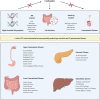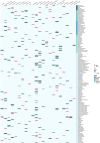Causal relationship between gut microbiota and gastrointestinal diseases: a mendelian randomization study
- PMID: 38263233
- PMCID: PMC10804519
- DOI: 10.1186/s12967-024-04894-5
Causal relationship between gut microbiota and gastrointestinal diseases: a mendelian randomization study
Abstract
Background: Recent research increasingly highlights a strong correlation between gut microbiota and the risk of gastrointestinal diseases. However, whether this relationship is causal or merely coincidental remains uncertain. To address this, a Mendelian randomization (MR) analysis was undertaken to explore the connections between gut microbiota and prevalent gastrointestinal diseases.
Methods: Genome-wide association study (GWAS) summary statistics for gut microbiota, encompassing a diverse range of 211 taxa (131 genera, 35 families, 20 orders, 16 classes, and 9 phyla), were sourced from the comprehensive MiBioGen study. Genetic associations with 22 gastrointestinal diseases were gathered from the UK Biobank, FinnGen study, and various extensive GWAS studies. MR analysis was meticulously conducted to assess the causal relationship between genetically predicted gut microbiota and these gastrointestinal diseases. To validate the reliability of our findings, sensitivity analyses and tests for heterogeneity were systematically performed.
Results: The MR analysis yielded significant evidence for 251 causal relationships between genetically predicted gut microbiota and the risk of gastrointestinal diseases. This included 98 associations with upper gastrointestinal diseases, 81 with lower gastrointestinal diseases, 54 with hepatobiliary diseases, and 18 with pancreatic diseases. Notably, these associations were particularly evident in taxa belonging to the genera Ruminococcus and Eubacterium. Further sensitivity analyses reinforced the robustness of these results.
Conclusions: The findings of this study indicate a potential genetic predisposition linking gut microbiota to gastrointestinal diseases. These insights pave the way for designing future clinical trials focusing on microbiome-related interventions, including the use of microbiome-dependent metabolites, to potentially treat or manage gastrointestinal diseases and their associated risk factors.
Keywords: Gastrointestinal disease; Gut microbiota; Mendelian randomization; SNPs.
© 2024. The Author(s).
Conflict of interest statement
The authors declare that they have no competing interests.
Figures



Similar articles
-
Causal relationship between gut microbiota and androgenetic alopecia: A Mendelian randomization study.Medicine (Baltimore). 2024 Dec 27;103(52):e41106. doi: 10.1097/MD.0000000000041106. Medicine (Baltimore). 2024. PMID: 39969294 Free PMC article.
-
Association between gut microbiota and malignant cardiac tumors: A two-sample Mendelian randomization study.Cancer Med. 2024 Jul;13(13):e7455. doi: 10.1002/cam4.7455. Cancer Med. 2024. PMID: 38953300 Free PMC article.
-
Causal relationship between gut microbiota and autoimmune thyroiditis: A mendelian study.Heliyon. 2024 Feb 6;10(3):e25652. doi: 10.1016/j.heliyon.2024.e25652. eCollection 2024 Feb 15. Heliyon. 2024. PMID: 38356548 Free PMC article.
-
Exploring the potential causal relationship between gut microbiota and heart failure: A two-sample mendelian randomization study combined with the geo database.Curr Probl Cardiol. 2024 Feb;49(2):102235. doi: 10.1016/j.cpcardiol.2023.102235. Epub 2023 Nov 30. Curr Probl Cardiol. 2024. PMID: 38040216 Review.
-
Deconstruct the link between gut microbiota and neurological diseases: application of Mendelian randomization analysis.Front Cell Infect Microbiol. 2025 Mar 6;15:1433131. doi: 10.3389/fcimb.2025.1433131. eCollection 2025. Front Cell Infect Microbiol. 2025. PMID: 40115072 Free PMC article. Review.
Cited by
-
Insights into Gut Microbiome Composition in Hidradenitis Suppurativa: A Comprehensive Examination of Dietary Habits and Environmental Influences.Nutrients. 2024 Jun 5;16(11):1776. doi: 10.3390/nu16111776. Nutrients. 2024. PMID: 38892709 Free PMC article.
-
The Gut Microbiota and Colorectal Cancer: Understanding the Link and Exploring Therapeutic Interventions.Biology (Basel). 2025 Feb 28;14(3):251. doi: 10.3390/biology14030251. Biology (Basel). 2025. PMID: 40136508 Free PMC article. Review.
-
Causal effect of gut microbiota on pancreatic cancer: A Mendelian randomization and colocalization study.J Cell Mol Med. 2024 Apr;28(8):e18255. doi: 10.1111/jcmm.18255. J Cell Mol Med. 2024. PMID: 38526030 Free PMC article.
-
Exploring the Causal Effects of Gut Microbiota on Diabetic Nephropathy: A Two-Sample Mendelian Randomization Study.Comb Chem High Throughput Screen. 2025;28(6):1026-1038. doi: 10.2174/0113862073311197240425073859. Comb Chem High Throughput Screen. 2025. PMID: 38676512
-
Inflammatory proteins may mediate the causal relationship between gut microbiota and inflammatory bowel disease: A mediation and multivariable Mendelian randomization study.Medicine (Baltimore). 2024 Jun 21;103(25):e38551. doi: 10.1097/MD.0000000000038551. Medicine (Baltimore). 2024. PMID: 38905376 Free PMC article.
References
-
- Milani C, Duranti S, Bottacini F, Casey E, Turroni F, Mahony J, Belzer C, Delgado Palacio S, Arboleya Montes S, Mancabelli L, et al. The first microbial colonizers of the human gut: composition, activities, and health implications of the infant gut microbiota. Microbiol Mol Biol Rev. 2017 doi: 10.1128/MMBR.00036-17. - DOI - PMC - PubMed
Publication types
MeSH terms
Grants and funding
LinkOut - more resources
Full Text Sources

